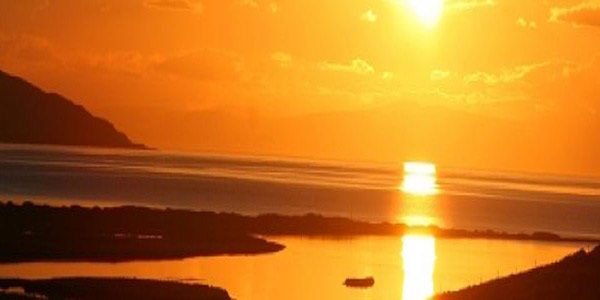Pythéas aborde les rivages de Thulé (Islande), après six jours de navigation vers le nord ; Il y observe le soleil qui ne se couche que quelques heures, et fait une nouvelle mesure de latitude.
Strabo is again there to give us a clue: "Pytheas tells us that Thule is six days' sailing from Britain in a northerly direction and that it is close to the frozen sea." (M44). But he also says that Pytheas is the "worst liar." Servius indicates, in his commentaries on Virgil, that Thule is located "between the north and the west beyond Britain..." (M47). Pliny adds about days and nights: "during the days of the solstice when the sun comes close to the top of the world, because of the enclosed path of light, the earth below has continuous days of six months as well as continuous nights in winter when it is in the opposite direction" (M52). Another text by Geminos in his astronomical treatise Introduction to Celestial Phenomena is very interesting: "It would appear that Pytheas the Massaliote had in fact been to these regions. He says, about the observations he noted in the ocean: The barbarians have pointed out to us on several occasions the place where the sun disappears. At this place, the night is extremely short: two hours for some, or three for others, and just after the sun rises again." (M48). A passage from Strabo gives us astronomical information: "The Massaliote Pytheas says that the extreme regions are those around Thule... close to the summer tropic which is the same as the Arctic Circle" (M50).
 |
Sunset in Iceland |
We know that Pytheas made a latitude measurement at the height of the Shetlands. But isn't it in Norway near Bergen? Then, did he go straight up to Iceland? Did he go all the way around it? To sail further north, no doubt.
Pytheas did go to Iceland, and Pliny says "the most remote of all the islands". Pytheas landed at Thule, no doubt his dream. He spent his nights (so short) observing the sun. And he knew then that he was right. The sun, when you are, in summer, in the north of Iceland, skims the horizon then rises again immediately. Another measurement with his gnomon gives him the latitude. Hipparchus will tell us 66°. Perhaps he wasn't in Iceland in the first days of summer because he wrote (Geminis says so) "the barbarians showed us where the sun sets". So he wouldn't have seen the midnight sun. Or was he simply south of Iceland. And there, the sun always sets a little. And then, let's not forget, we only have a tiny part of Pytheas' writings.
He discovered an island that would normally be too cold to live on. And yet a people live there. What he could not know is the existence of the Gulf Stream, a warm current that provides its benefits beyond the polar circle.
In Thule, Pytheas is faced with a temporal problem. The day of the Greek world is traditionally divided into two equal parts of twelve hours (horas). But, since he goes north, he notices that the twelve hours of the night are very different and much shorter. And to top it all off, in Thule, there are no more nights, so twenty-four hours last twelve hours? Difficult to admit. Wouldn't it be more logical to admit that the hours have a fixed duration? Thus in Thule the summer days have a duration of twenty-four hours and there are no hours of night. The problem is solved.
We think that Pytheas was the first to have this idea. In any case, it is certain that it corresponds entirely to what he observes. Later, Geminos (see quote above) will use this system. When Pytheas, through Strabo, evokes the summer tropic (Tropic of Cancer), which is the same as the Arctic Circle, he simply means that they have the same latitude, one from the equator, the other from the North Pole. In fact Pytheas measures the obliquity of the ecliptic again.

